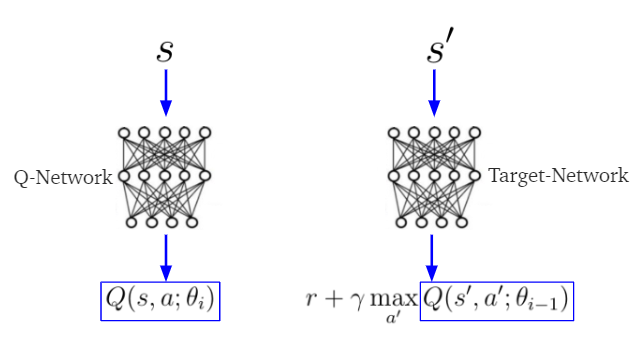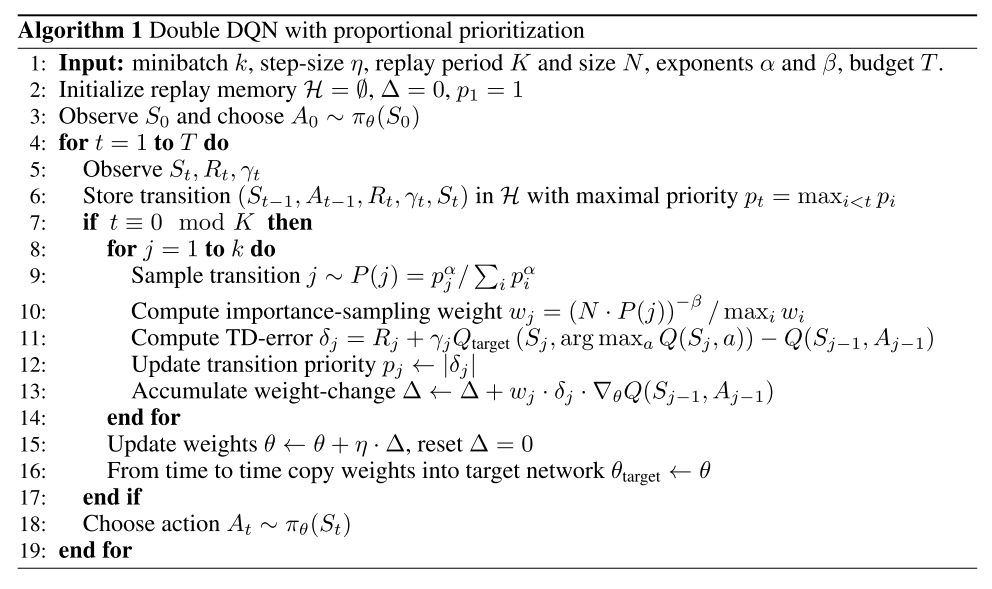Rainbow: Combining Improvements in Deep Reinforcement Learning
Paper SourceJournal: The Thirty-Second AAAI Conference on Artificial Intelligence (AAAI-18)Year: 2017Institute: DeepMindAuthor: Matteo Hessel, Joseph Modayil, Hado van Hasselt#Deep Reinforcement Learning
Abstract
This paper examines six main extensions to DQN algorithm and empirically studies their combination. (It is a good paper which gives you a summary of several important technologies to alleviate the problems remaining in DQN and provides you some valuable insights in this research region.)Baseline: Deep Q-Network(DQN) Algorithm Implementation in CS234 Assignment 2
1.INTRODUCTION
Because the traditional tabular methods are not applicable in arbitrarily large state spaces, we turn to those approximate solution methods (linear approximator & nonlinear approximator value-function approximation & policy approximation), which is to find a good approximate solution using limited computational resources. We can use a linear function, or multi-layer artificial neural networks, or decision tree as a parameterized function to approximate the value-function or policy.(More, see Sutton’s book Reinforcement Learning: An Introduction Chapter 9).
The following methods are all value-function approximation and gradient-based(using the gradients to update the parameters), and they all use experience replay and target network to eliminate the correlations present in the sequence of observations.
1> Linear
Using a linear function to approximate the value function(always the action value).
$w$ is the parameters, $x(s)$ is called a feature vector representing state $s$, and the state $s$ is the images(frames) observed by the agent in most time. So a linear approximator implemented with tensorflow can be just a fully-connected layer.1
2
3
4
5import tensorflow as tf
# state: a sequence of image(frame)
inputs = tf.layers.flatten(state)
# scope, which is used to distinguish q_params and target_q_params
out = layers.fully_connected(inputs, num_actions, scope=scope, reuse=reuse)
2> Nonlinear - DQN
Deep Q-Network. The main difference of DQN from linear approximator is the architecture of getting the q_value, it is nonlinear.
And the total algorithm is as follows:
The approximator of DeepMind DQN implemented with tensorflow as described in their Nature paper can be:1
2
3
4
5
6
7
8import tensorflow as tf
with tf.variable_scope(scope, reuse=reuse) as _:
conv1 = layers.conv2d(state, num_outputs=32, kernel_size=(8, 8), stride=4, activation_fn=tf.nn.relu)
conv2 = layers.conv2d(conv1, num_outputs=64, kernel_size=(4, 4), stride=2, activation_fn=tf.nn.relu)
conv3 = layers.conv2d(conv2, num_outputs=64, kernel_size=(3, 3), stride=1, activation_fn=tf.nn.relu)
full_inputs = layers.flatten(conv3)
full_layer = layers.fully_connected(full_inputs, num_outputs=512, activation_fn=tf.nn.relu)
out = layers.fully_connected(full_layer, num_outputs=num_actions)
Do DQN from scratch(sample version)
3> Nonlinear - DDQN
Double DQN. The main difference of DDQN from DQN is the way of calculating the target q value.
As a reminder,
In Q-Learning:
In DQN:
where $\theta_{i-1}$ is the target network parameters which is always represeted with $\theta_t^-$.
There is a problem with deep q-learning that “It is known to sometimes learn unrealistically high action values because it includes a maximization step over estimated action values, which tends to prefer overestimated to underestimated values” as said in DDQN paper.
The idea of Double Q-learning is to reduce overestimations by decomposing the max operation in the target into action selection and action evaluation.
Implement with tensorflow (the minimal possible change to DQN in cs234 assignment 2)1
2
3
4
5
6
7
8
9
10
11
12
13# DQN
q_samp = tf.where(self.done_mask, self.r, self.r + self.config.gamma * tf.reduce_max(target_q, axis=1))
actions = tf.one_hot(self.a, num_actions)
q = tf.reduce_sum(tf.multiply(q, actions), axis=1)
self.loss = tf.reduce_mean(tf.squared_difference(q_samp, q))
# DDQN
max_q_idxes = tf.argmax(q, axis=1)
max_actions = tf.one_hot(max_q_idxes, num_actions)
q_samp = tf.where(self.done_mask, self.r, self.r + self.config.gamma * tf.reduce_sum(tf.multiply(target_q, max_actions), axis=1))
actions = tf.one_hot(self.a, num_actions)
q = tf.reduce_sum(tf.multiply(q, actions), axis=1)
self.loss = tf.reduce_mean(tf.squared_difference(q_samp, q))
Do Double DQN from scratch(sample version)
4>Prioritized experience replay
Prioritized experience replay. Improve data efficiency, by replaying more often transitions from which there is more to learn.
And the total algorithm is as follows:
Temporal-Difference(TD) Error
TD-Error:
Where the value $r + \lambda V(s’) $ is known as the TD target.
Experiences with high magnitude TD error also appear to be replayed more often.Stochastic Prioritization
- Importance Sampling(IS)
5>Dueling network architecture
Dueling network architecture. Generalize across actions by separately representing state values and action advantages.
6>Multi-step bootstrap targets in A3C
Multi-step bootstrap targets. Shift the bias-variance tradeoff and helps to propagate newly observed rewards faster to earlier visited states.
7>Distributional Q-learning
Distributional Q-learning. Learn a categorical distribution of discounted returns, instead of estimating the mean.
8>Noisy DQN
Noisy DQN. Use stochastic network layers for exploration.
REFERENCES
1.Self Learning AI-Agents III:Deep (Double) Q-Learning(Blog)
2.【强化学习】Deep Q Network(DQN)算法详解(Bolg)